|
Our Bundy Quaker Heritage
Our Bundy line hales from the
Amesbury, Wiltshire, England area. They were Quakers, and it is
assumed that they left England (in the mid 1600's) for the new country in
hopes of living their lives free of religious persecution. The
Wiltshire area is home to Stonehenge and several other historical landmarks.
To learn more about the area, see this
website. For some photos
of the Wiltshire area, see this
page.
Recent information indicates
that (possibly) the parents of William were a James Bundy, 1587, who
married Nov 8, 1602 to Agnes Child. They lived in Roxton, Beds, England.
This James Bundy was the son of another James Bundy and it stops there.
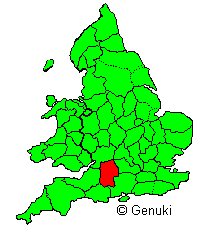
Some Random Information on
the Name
The name Bundy comes from the ancient English expression Bond which used to
signify a member of a tribe bound together by loyalty to their chief. Later
the name came to signify a farmer holding lands from a Lord. Probably
different Bundys emigrated from England to Virginia and North Carolina. One
of them was William Bundy, born 1630, died March 27, 1692 (wife Elizabeth,
born 1640, died March 4, 1676 or 1677) who emigrated around 1660 first to
Rhode Island and then on to Albermaro Colony - later known as North
Carolina. He was a Quaker, a lawyer, a judge, and a member of the Council of
Albormoro Colony around 1690.
Bounds
is a patronymic form of the name Bound, meaning "son of
Bound" and Bound is a variation of the English, Swedish, Norwegian
name Bond, derived from Old Norse bonde = farmer. It
designated a peasant farmer, and was also used as a given name, which lead
to many Scandinavian surnames. After the Norman conquest, the word
bond/bound took a dive in status, and came to be understood as "bound
servitude" or "free landholder bound by loyalty to the landlord" but
originally, and among Scandinavians, it meant simply "farmer." Variations
are Bonde, Bound, Boundey, Bundey,
Bundy . Bönde,
Bonne are Norwegian and Danish cognates. Bunde is the Low German
form. Bounds, Bonds are English patronymic forms while Bondesen and
Bonnesen are found among the Scandinavians.
"The Bundy Family"
(From "Our Ancestors - The Stantons" by William Henry Stanton)
"The Bundy family, from its
close and many connections with the Stanton family, is one of special
interest. "It is hoped that some one will make a thorough investigation, and
record the full history and genealogy of the Bundy family, which cannot be
attempted here.
"Tradition indicates that the
family was in France in the Eleventh Century and probably takes its name
from, or gives its name to the Forest of Bondy; and that some members came
to England in 1066, with the Normans under William the Conqueror, as the
name Bandy appears on the battle rolls of some of the chiefs. It is probable
that due to carelessness or difference of pronunciation, the spelling was
changed to Bundy.
"It appears they settled first
in the rugged hills of Wales and later moved to Yorkshire, England.
Tradition also says that five brothers emigrated from York, England, and
landed on the coast of Virginia or North Carolina, and that one of the
brothers became dissatisfied and moved north to what is now known as New
York State, and never returned. A family of Bundys now located there
resembles those from North Carolina and seems to confirm this tradition.
"While some of the early
members were fierce warriors and while several members volunteered for
service in the Rebellion, the large majority of the family has followed
agriculture and the members earned their living in peaceful way.
Some More Information:
The First American
Bundy's
"According to the Connecticut Historical
Society, the first Bundy in America is said to have been one John Bundy or
Bunde, who came from England before the year 1635 and settled first at
Plymouth, Mass., whence he soon removed to Boston and later to Taunton in
the same Colony. From Plymouth Colonial Records comes this entry, "At a
court of Assistants held the 6th March 1635, whereas John Bundy stands bond
by indenture to serve Griffin Montegue, carpenter, in New England, the full
term of eight years from the 14th of March 1635, the said John Bundy
acknowledged himself content to serve out the remainder of his term with
Eilt Brewster, the Elder of Plymouth, who hath compounded with the said
Montegue, his master."
"At a Court of Assistants held the XXIth
August, in the XIIIth year of King Charles, etc., "John Bundy was examined
and found guilty of lewd behavior in vicious carriage towards Elizabeth
Haybell, in the house of Mr. and Mrs. William Brewster, and is therefore
adjudged to be severely whipped, which was executed upon him accordingly."
"On January 8, 1638 Mr. Brewster hath
assigned over to Jonathan Brewster, his son, all his interest and title into
his service of John Bundy for the residue of his term, which is five years
from the fourteenth of March next."
"John Bundy, aged 64 or thereabout made his
last will and testament on April 5, 1681 (probated October 29, 1681). By
this time he owned land and a home. His will records the following children:
By his first wife, Martha Chandler who died
5/1/1674
-
Martha Bundy, b. 2 Nov 1649
-
Mary Bundy, b. 5 Oct 1653. m. Edward
Smith, b. 1648, d. 1707
-
James Bundy, b. 29 Dec 1644, d. 1721. m.
Mary Briggs.
-
Patience Bundy, b. 27 Mar. 1665.
-
Sarah Bundy, b. 4 Mar. 1669
-
By his second wife, Ruth Gurney
-
John Bundy, b. 1677.
-
Joseph Bundy, b. 1679.
-
Edward Bundy, b. 1681.
"It should be remembered that the
punishment of John Bundy for "lewd behavior" was typical of the treatment of
some indentured servants, minorities, and political prisoners of this era.
In spite of the proclamations of the founding fathers regarding freedom,
religion, and democracy, their actions towards the poor, debtors, and the
religiously unorthodox were a far cry from their affirmations.
Unfortunately, the strong often extended their strength over the weak.
"If and when these two early American
Bundys', John and William, are officially linked, their descendants will no
longer be able to assign so-called "undesirables" to the other line. There
are nationally and internationally known members in both lines as well as
many ordinary Americans; indeed, we represent a good cross-section of
American life."
The above will provide you with the surname
for Mary, and a lot of other good information. We hope it provides you with
the desire to join us in our pursuit to link us together. You could be a
valuable participant in performing this linkage and merger. Looking forward
to your reply.
Best Wishes, Bruce Wood
The Arrival of the Bundys, from V. Mayo's Book
William Bundy was the original
Quaker Bundy in the Colony of Carolina. He may have been the lineage of
William Bundy the Elder and Elliner, his wife of Wiltshire, England
and a brother of John Bundy of Massachusetts. It is possible that William
and Elizabeth purchased two hundred acres of land in what is now South
Kingston, Rhode Island, May 1st, 1663. Twenty acres was laid out as a house
lot, 'and he hath built upon it." Evidently William Bundy remained in
possession of the land only five or six months when he sold it on October
27, 1663 to Jirah Bull, the "Fearless Quaker" who was one of the first
Quakers to settle in Narrahansett County, Rhode Island. The deed is signed
by William Bundy and "X", the mark of Elizabeth Bundy. The deed states that,
"I, William Bundy, late Narragansett, now bound for Carolina do assign to
Jirah Bull..." The document thus proves that William Bundy was married to
Elizabeth before October 27, 1663 the date of the deed, and that both left
Rhode Island for Carolina about that time, and were certainly among the
first settlers from New England to North Carolina. The Eight Lords
Proprietors had, by 1665, outlined a plan by which they proposed to
administer the civil affairs of the territory. Southeastern Virginia, which
was adjacent to Albemarle region of Carolina to which the Bundy's had come,
was already settled. In 1663 charter Charles II gave to the Eight Lords
Proprietors. Bundy's and other Quakers took out patents for their new land.
|
Some
Interesting Information on the Area:
History of Nixonton Township
Nixonton, Elizabeth City's
nearest Pasquotank neighbor, is said to be 55 years older than Elizabeth
City. At one time in the history of these two communities, the population of
Nixonton was 10 times that of Elizabeth City, Nixonton having 600 with
Elizabeth City having only 60.
Nixonton, the oldest community
in Pasquotank County, is situated on the north bank of the Little River
which forms a complete boundary between the counties of
Perquimans and Pasquotank. A study of
its more then 200 years of history discloses a series of events and
happenings of which residents can be proud. One mile north of Nixonton, at
Hall's Creek, the first Albemarle Assembly met, on February 6, 1665, under a
big oak tree.
From 1705 to 1708, Charles
Griffin taught the first school in North Carolina at Symond's Creek, which
is about a mile east of Nixonton. Nixonton was the third county seat of
Pasquotank County (1785-1799).
From the Colonial Records of
1758, an interesting account of the chartering of Nixonton reads as follows:
"Whereas it has been represented to the Assembly that in the year of Our
Lord 1746, 161.5 acres of land were purchased from Zachariah Nixon for a
town and commons - 50 acres of which laid out in one-half-acre lots with
convenient streets - that there are now upwards of 20 habitable houses
erected thereon and upwards of 70 inhabitants and the same might be improved
if it were enacted into a town by lawful authority.
Be it therefore enacted by the
Council and Assembly and by authority of same that said 161.5 acres of land
be and the same is hereby constituted, enacted and established a town and a
town commons, and shall be called by the name Nixon's Town.
And be it further enacted by
the authority of the aforesaid that from and after passing this act Joseph
Robertson, Thomas Nicholson, William Lane, Aaron Morris, and Francis Nixon
be and they and everyone of them are hereby constituted directors and
trustees for designing, building, carrying on the said town.
Provided nevertheless that
every grantee of any lot or lots in the said town so conveyed shall within
three years next after date of purchase erect, build, and finish on each ot
so conveyed, one good habitable house with a brick or stone chimney - house
20 feet long, 15 feet wide, 9 feet pitch in the clear, or proportionate to
such dimensions.
There are only three of these
old houses now standing. The old Customs House, the first in North Carolina,
now owned by the Eugene Scott family; the John Morris place, where the
Richard Barclift family lives; and the Halstead House, moved and restored by
Miss Mary Yarborough of Raleigh and Misses Minnie and Elizabeth Nash of
Elizabeth City.
From old records dated
September 20, 1785, it is found that surviving directors and trustees of the
town of Nixonton made and indenture to Devotion Davis and Benjamin White,
two commissioners appointed by Act of Assembly to erect a court house,
prison, pillory, and stocks for the County's use, for five pounds paid by
the commissioners.
After Nixonton became
incorporated into a town, its citizens turned their eyes to education. In
1803 nineteen men were appointed trustees to build a Nixonton Academy. The
academy was chartered in 1804. By the middle 1830s, it was abandoned and
move to Symond's Creek. It was recently restored by its present owner, Miss
Imogene Riddick.
Prior to the Civil War period,
Nixonton was a flourishing community, with a court house, jail, four stores,
a gin, sawmill, a coach factory, shipyard, three taverns, and two
ordinaries. For many years a lively trade was carried on between Nixonton
and the West Indies and England.
Today, Nixonton is a quiet
residential community of approximately 25 families.
I don't know what it looks
like today, but in 1977 it was a semi-summer vacation area, with lots of
small boats, trailers and camp areas. Hardly seems like a once thriving
metropolis. Since my Bundy, Overman and other roots go back to this area, I
thought some of the rest of you with similar roots might enjoy reading this.
Best Wishes, Bruce Wood
The Albemarle in 1672 as
Described by George Fox
The following is from the Yearbook of
Pasquotank Historical Society, Vol. 2. and was written by John Elliott Wood
The famous Quaker missionary George Fox
(1624-1691) sailed from England the Fall of 1671 for Barbadoes, later going
to Jamaica. In his party was William Edmundson who was delegated to go to
Virginia and Carolina when the evangelists divided their labors. Fox kept a
faithful record which reflects conditions of the time, the following being a
typical entry after arrival of the party in Maryland the spring of 1672:
"We parted company, dividing ourselves unto
several coasts, for the service of truth. James Lancaster and John
Cartwright went by sea for New England; William Edmundson and three friends
more sailed for Virginia, where things were much out of order; ...."
During the summer of 1672, he wrote from
Long Island:
"While we were in Shelter-island, William
Edmundson came to us, who had been laboring in the work of the Lord in
Virginia. From whence he traveled through the Desert-country, through
difficulties and many trials, till he came to Roan-oak, where he met with
tender people...."
This "Roan-oak" refers to the Albemarle
section of North Carolina, and specifically to Perquimans and Pasquotank.
The reports given by Edmundson must have led Fox to the decision to visit
Carolina. His journal later in 1672 reads as follows:
"The fifth of the ninth month we set sail
for Virginia, and in three days came to Nancemum, about two hundred miles
from Maryland.... we had a great meeting .... After the meeting, we hastened
towards Carolina; yet had several meetings by the way..."
"After this, our way to Carolina grew
worse, being much of it splashy, and pretty full of great bogs and swamps;
so that we were commonly wet to the knees, and lay abroad a-nights in the
woods by fire; saving one of the nights we got to a poor house at Sommertown,
and lay by the fire ..... Next day, the twenty-first of the ninth month,
having traveled hard through the woods, and over many bogs and swamps, we
reached Bonner's Creek; there we lay that night by the firesides, the woman
lending us a mat to lie on."
"This was the first house we came to in
Carolina: here we left our horses, over-wearied with travel. From whence we
went down the creek in a canoe to Macocomocock River, and came to Hugh
Smith's, where people of other professions came to see us (no friends
inhabiting that part of the country) and many of them received us gladly.
Among others, came Nathaniel Batts, who had been governor of Roan-oak. He
went by the name of Captain Batts, and had been a rude, desperate man ...."
"Not far from hence we had a meeting among
the people.... Then passing down the River Maratick in a canoe, we went down
the bay Connie-oak, to a captain's, who was loving to us, and lent us his
boat, for we were much wetted in the canoe, the water flashing in upon us.
With this boat we went to the governor's; but the water in some places was
so shallow, that the boat, being laden, could not swim; so that we put off
our shoes and stockings, and waded through the water a pretty way. The
governor, with his wife, received us lovingly.... We tarried at the
governor's that night; and next morning he very courteously walked with us
himself about two miles through the woods to a place whither he had sent our
boat about to meet us. Taking leave of him, we entered our boat, and went
thirty miles to Joseph Scot's, one of the representatives of the country.
There we had a sound, precious meeting; the people were tender, and much
desired after meetings. Wherefore at an house about four miles further, we
had another meeting; to which the governor's secretary came, who was chief
secretary of the province, and had been formerly convinced."
"I went from this place among the Indians,
and spoke to them by an interpreter..... There was among them their young
king and others of their chief men, who seemed to receive kindly what I said
to them."
"Having visited the north part part of
Carolina, and made a little entrance for truth upon the people there, we
began to return again towards Virginia, having several meetings in our way,
wherein we had good service for the Lord, the people being generally tender
and open.... In our return we had a very precious meeting at Hugh
Smith's;..... The ninth of the tenth month we got back to Bonner's Creek,
where we had left our horses; having spent about eighteen days in the north
of Carolina."
"Our horses having rested, we set forward
for Virginia again, traveling through the woods and bogs as far as we could
well reach that day, and at night lay by a fire in the woods. Next day we
had a tedious journey through bogs and swamps,..... We got that night to
Sommertown..... both in Virginia and Carolina they generally kept great dogs
to guard their houses, living lonely in the woods..... Here we lay in our
clothes by the fire, as we had done many a night before. Next day we had a
meeting; for the people, having been informed of us, had a great desire to
hear us;.... After the meeting we hasted away....."
Quotations are from "Journal or Historical
Account of the Life, Travels, Sufferings, Christian Experiences....of .....
George Fox" published in 1832 in Philadelphia, containing a lengthy preface
by William Penn. Fox was a prolific and remarkable writer, and his Journal
was first published in England in 1694. From the account of his travels,
much may be gleaned of conditions then current. Reference to "Sommertown"
indicates that his course on horseback from "Nancemun" (Nansemond) was along
one of the trails west of the Great Dismal to the present Somerton; and that
a day's travel "over many bogs and swamps" brought him to "Bonner's Creek
(Bennett's Creek) where the horses were left, the first house in Carolina.
Apparently other families lived in the vicinity of Hugh Smith's since a
meeting was convened. That they were not Quakers, however, indicates a
hunger of those pioneers of the forests for contact with the outside world;
also a dearth of any sort of religious influence in those parts. Captain
Nathaniel Batts was a legendary character of early Albemarle of whom little
of fact is recorded. Apparently he was an early hunter and trapper who
became a leader among the Indians, which may explain the reference of his
having been "governor of Roan-oak" He held no such office under the
Proprietary government.
The "river Maratick" was the Chowan, as it was shown
on maps of that period. The governor referred to was Peter Carteret, kinsman
of Sir George Carteret, one of th Proprietors, who held office from 1670
until he wearied of the office and returned to England in 1673. The
governor's courtesies to the itinerant preacher is my no means surprising in
view of his amiable disposition and a natural desire for the company and
conversation of a well-known traveler like Fox. We can imagine the pleasure
of Governor Carteret in hearing recent news of doings in England, which he
had left in 1664. The location of the governor's seat is uncertain, but
probably was in Chowan and on the Sound or some principal river as most
homes were in a day when there were few roads. It may have been near the
present location of Edenton. Nor is it certain where Joseph Scot resided,
except that it was thirty miles distant from the governor's. Scot was a
member of the elected assembly; and his name appears on the Quaker
Remonstrance to the King dated 7-13-1679. He probably lived in Perquimans or
Pasquotank, and evidently among enough neighbors to afford a "sound,
precious meeting" The governor's secretary who lived in another settlement
four miles from Scot is not identified except that he was a Quaker; nor is
the location of the Indians whom he preached to identified. It is apparent,
however, that the Indians and the settlers were on good terms with each
other at the time. That the habitations were primitive and the people
friendly to strangers is clear; but the pioneers were not without dependable
and even threatening watch dogs to warn them of the approach of outsiders.
It is from such primary sources as the
writings of Edmundson, Fox, Lawson, and others which have survived that we
can reconstruct conditions in Albemarle as they were prior to 1700.
I lived for a year in Virginia Beach and
made the trip by car several times through the Great Dismal Swamp. Also
traveled around the many inlets in the area around Elizabeth City and
Nixonton. I have come to appreciate the great hardships that overland travel
must have been in those days. The Bundy's lived in the area as early as 1660
as did the Overman's,
Bogue's, Winslow's, Nicholson's etc. Reading an
account like the above is probably as close as I will get to knowing what
life was like for my early ancestors. I do know that Quakers who landed in
Virginia were often whipped and taken to the Carolina border and dumped. It
is from such "riff-raff" that I proudly descend.
Best Wishes, Bruce Wood
|
|
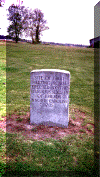 |
First Site of a Quaker Meeting in North Carolina
Photo taken 2001,
courtesy of Denise Mayo Clark
click on the image to
enlarge. |
First Generation
William BUNDY. Born on 25 Nov 1618 in
Wiltshire, England. William died in England. William married Ellinor
?
Known Child:
| i |
William Bundy (1630-1692) |
Second Generation
William BUNDY.
The
Immigrant. Born in 1630 in England. William died in Berkeley Pct.
Perquimans Co.,
NC on 27 Mar 1692, he was 62. In 1663 when William was 33, he married
Elizabeth ?. Born in 1644 in Berkeley Pct. Perquimans Co., NC. Elizabeth
died in Berkeley Pct. Perquimans Co., NC on 4 MAR 1675/76, she was 31.
|
Some More on William:
He married twice. He married
Elizabeth ?? in RI (prob.), 1663. Elizabeth was born abt 1640
in England. Elizabeth died 4 Mar 1675/76 in Perquimans County, North
Carolina, at 35 years of age. He married Mary Scott Pierce in
Perquimans County, North Carolina, 15 Dec 1683. Mary was born 1649. Mary
died 22 Mar 1723/24 in Pasquotank County, North Carolina, at 74 years of
age. She was the widow Pierce at time of marriage to William Bundy.
The Bundy family is of French descent, originally spelling their name
Bundeie. According to the family tradition, their ancestors were among the
French Huguenots driven out of France by the Catholic persecutions who
settled in Wales. About the middle of the 17th century some of the more
venturesome sailed from Pembroke, Wales, for America. Members of the family
residing in Worcestershire in southwest England adopted as the family crest,
a hand, holding an eagle's leg and had as their motto, Certum pete finem."
(Aim at a sure end.)
Coming probably from
Worchestshire, England, to Massachusetts, William and wife Elizabeth
appeared first in Rhode Island where they purchased 200 acres of land in
1663. In less than six months they sold the land and William and Elizabeth
were among the first emigrants from New England to North Carolina.
The Bundys' settled on
plantations reaching out from both banks of Little River, that forms a
natural boundary between Pasquotank County and Perquimans County, NC.
Albemarle County was abolished in 1729 when each of the four precincts,
Perquimans, Pasquotank, Curritack, and Chowan became a county.
William Bundy was a cord
twainer by trade. He settled in Perquimans Precinct but the date is unknown.
|
William and Elizabeth had following
children:
|
i. |
Mary
Bundy (~1660-1694), Mary Bundy maried Timothy Clare, son of |
|
ii. |
Hannah
Bundy
Born in 1670 in Perquimans Co., North Carolina. Hannah married John
LAWRENCE. |
|
iii |
William
Bundy
Born in 1671 in Perquimans Co., North Carolina. William died on 28 Jul
1700, he was 29. |
|
iv. |
Samuel
Bundy (1675-1739) |
|
v. |
Caleb Bundy Born
in 1677 in Perquimans Co., North Carolina. Caleb died on 1 MAR
1720/21, he was 43. Caleb married Jane MANERS.
|
Third Generation
 Samuel BUNDY. Born on 4 FEB 1675/76 in
Berkeley Prct., Perquimans, NC. Samuel died in Pasquotank Co., North
Carolina on 14 MAR 1739/40, he was 64.
On 5 Oct 1696 when Samuel was 21, he married Tamar SYMONS,
daughter of Jeremiah SYMONS & Ann ?, in Pasquotank Co., NC. Born on 4
Oct 1680 in Pasquotank Co., North Carolina. Tamar died in Pasquotank Co., NC
on 17 MAR 1718/19, she was 37. Samuel BUNDY. Born on 4 FEB 1675/76 in
Berkeley Prct., Perquimans, NC. Samuel died in Pasquotank Co., North
Carolina on 14 MAR 1739/40, he was 64.
On 5 Oct 1696 when Samuel was 21, he married Tamar SYMONS,
daughter of Jeremiah SYMONS & Ann ?, in Pasquotank Co., NC. Born on 4
Oct 1680 in Pasquotank Co., North Carolina. Tamar died in Pasquotank Co., NC
on 17 MAR 1718/19, she was 37.
They had the following children:
|
i. |
Joseph
Bundy -
Born in Pasquotank Co., NC |
|
ii. |
Jeremiah
Bundy -
Born in Pasquotank Co., NC |
|
ii. |
Samuel
Bundy -
Born on 26 Jul 1697 in Pasquotank Co., NC
Samuel married Mary WINSLOW |
|
iv. |
William
Bundy -
Born in 1700 in Pasquotank Co., NC |
|
v. |
Josiah
Bundy - (1710-1761) |
|
vi. |
Jane Bundy
- Born abt 1712 in Pasquotank Co.,
NC. Jane died in Pasquotank Co., NC on 17 Sep 1788, she was 76. Jane married ? PIKE. |
Fourth Generation
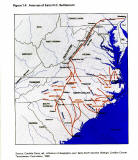
Josiah BUNDY. Born in 1710 in
Pasquotank Co., North Carolina. Josiah died in Perquimans Co., North
Carolina in Jan 1761, he was 51.
On 4 Dec 1735 when Josiah was 25, he married Elizabeth BARROW,
daughter of Joseph BARROW & Jane NICHOLSON, in Pasquotank, N.C. Born
on 5 Nov 1715 in Perquimans, Co., North Carolina. Elizabeth died in
Pasquotank, Co., North Carolina on 23 Dec 1796, she was 81. They had the following children:
|
i. |
Sarah Bundy
- Born
on 22 Aug 1736 in Pasquotank Co., NC. |
|
ii. |
Ellis Bundy
- Born
on 26 Oct 1738 in Pasquotank Co., NC. Ellis died in Pasquotank Co., NC
on 14 Mar 1762, he was 23. |
|
iii. |
Joseph
Bundy (1738-1762) |
|
iv. |
Ellis Bundy
- Born
on 1 Jul 1741 in Pasquotank Co., North Carolina. Ellis died in
Pasquotank Co., North Carolina on 14 Mar 1762, he was 20. |
|
v. |
Joshua
Bundy -
Born on 11 JAN 1743/44 in Pasquotank Co., NC. On 7 Aug 1763 when
Joshua was 20, he married Elizabeth BAILEY, in Pasquotank, NC. |
|
vi. |
Josiah
Bundy (1748-1810) |
|
vii. |
Jane Bundy Born
on 8 May 1751 in Pasquotank Co., NC. Jane died in Pasquotank Co., NC
on 28 Feb 1801, she was 49. Jane first married John NIXON.
On 12 Dec 1765 when Jane was 14, she second married Thomas SYMONS, in Pasquotank, NC. |
|
viii. |
Caleb Bundy
- Born
in Nov 1753 in Pasquotank, NC. Caleb died in Springfield, Guilford
County, NC on 10 May 1816, he was 62. On 1 Jun 1774 when Caleb
was 20, he married Sarah WILSON, in Wilkes, Springfield, North
Carolina. |
|
ix. |
Sarah Bundy
- Born
on 18 Sep 1756 in Pasquotank, Co., NC. Sarah died in Pasquotank, Co.,
NC on 14 Jul 1789, she was 32.On 27 Sep 1775 when Sarah was 19, she
married Jesa SYMONS, in Pasquotank Co., NC.
|
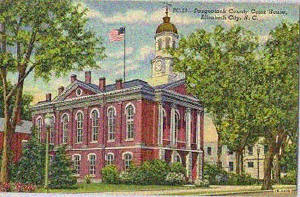
Pasquotank County, Courthouse
Fifth Generation
 Joseph BUNDY. Born on 26 Dec 1738 in
Pasquotank Co., North Carolina. Joseph died in Pasquotank Co., North
Carolina on 28 Mar 1762, he was 23.
On 4 Jan 1758 when Joseph was 19, he married Sarah BOGUE,
daughter of William BOGUE, 5TH & Sarah F. DUKE, in Perquimans,
NC. Born on 1 MAR 1737/38 in Perquimens County, N. Carolina. Joseph BUNDY. Born on 26 Dec 1738 in
Pasquotank Co., North Carolina. Joseph died in Pasquotank Co., North
Carolina on 28 Mar 1762, he was 23.
On 4 Jan 1758 when Joseph was 19, he married Sarah BOGUE,
daughter of William BOGUE, 5TH & Sarah F. DUKE, in Perquimans,
NC. Born on 1 MAR 1737/38 in Perquimens County, N. Carolina.
Joseph Bundy
and Sarah Bogue had the following children:
|
i. |
William
Bundy -
Born on 15 Nov 1760 in Pasquotank Co., North Carolina. |
|
ii. |
Josiah
Bundy (1760-1797) |
|
iii. |
Joseph
Bundy (1762-1808)
|
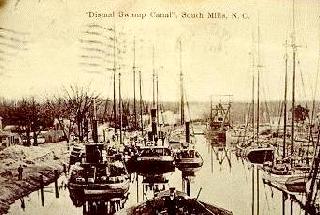
Sixth Generation
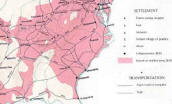
Joseph BUNDY. Born in 1762 in
Pasquotank Co., North Carolina. Joseph died in Pasquotank, North Carolina on
21 Dec 1808, he was 46. 3
Feb 1768 when Joseph was 6, he married Elizabeth HENLEY, daughter of
Joseph HENLEY & Mourning ANDERSON, in Perquimans, NC. Born on 25 Mar
1769 in Pasquotank Co., North Carolina. Elizabeth died in Pasquotank Co.,
North Carolina on 12 Apr 1815, she was 46.
They had the following children:
|
i. |
Mary Bundy
(1787-1853) |
|
ii. |
Benjamin
Bundy (1789-1825) |
|
ii. |
Jesse Bundy
(1792-) |
|
iv. |
John Bundy
- Born
on 13 Jun 1794 in Pasquotank, N. Carolina. John married Mary
CLARK DAVIS. Born in Pasquotank, NC. |
|
v. |
Joseph
Bundy -
Born on 29 Aug 1796 in Of Pasquotank Co., NC. Joseph married
Charlotte RHODES. Born in Pasquotank, NC. |
|
vi. |
Thomas
Bundy -
Born on 6 Nov 1798 in Pasquotank, NC. Thomas married Martha ?.
Born in 1798 in Pasquotank, NC. |
|
vii. |
Rix Bundy (1801-) |
|
viii. |
William
Bundy (1807-) |
Seventh Generation
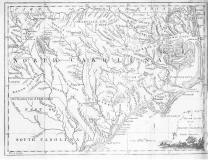 Benjamin BUNDY. Born on 13 Mar 1789
in Pasquotank Co., North Carolina. Benjamin died on 19 Mar 1825, he was 36. 26 Apr 1810 when Benjamin was
21, he married Penninah DELON, daughter of Mark DELON & Ann TAYLOR,
in Symons Creek, North Carolina. Born on 27 Jan 1792 in Pasquotank Co.,
North Carolina. Penninah died on 16 Oct 1872, she was 80 (in Henry County,
IN). Mark Delon was drafted
into the Revolutionary Army at Pasquotank. Benjamin BUNDY. Born on 13 Mar 1789
in Pasquotank Co., North Carolina. Benjamin died on 19 Mar 1825, he was 36. 26 Apr 1810 when Benjamin was
21, he married Penninah DELON, daughter of Mark DELON & Ann TAYLOR,
in Symons Creek, North Carolina. Born on 27 Jan 1792 in Pasquotank Co.,
North Carolina. Penninah died on 16 Oct 1872, she was 80 (in Henry County,
IN). Mark Delon was drafted
into the Revolutionary Army at Pasquotank.
On 17th of 3rd Month,
1810, Benjamin Bundy, son of Joseph and Elizabeth Bundy of Pasquotank County
and Penninah Delon appeared and published their intention of marriage.
Aaron Morris, Jr. and Benjamin Pritchard were appointed to make inquiry and
on the 21st of 4th month 1810 they appeared and desired an answer to their
request. Clearness was granted and they were at liberty to accomplish
their desire. Thomas White, Jr. and Thomas Jordan were appointed to
attend the wedding on the 17th of 5th month 1810 and reported that "Friends
behaved orderly."
According to Hinshaw's Quaker Records from
North Carolina, Benjamin Bundy and Penninah Delon had the following
children:
|
i |
Martha
Bundy (1811-1862); our line |
|
ii |
William
Bundy
Born on 18 Feb 1812 in Pasquotank, NC. William died on Aug 19,
1902 in Henry County, Greensboro twsp, Indiana.
From my cousin Adrian Whicker: Your Bundy was Martha and
mine was
her brother William who moved to Henry County, IN between April 1861
and 1870. Nobody seems to have any info on William, so I thought I
would fill you in. William moved to Guilford County with his wife
Martha Pike from Pasquotank County sometime after 1841. He shows up in
the 1850 Guilford County census with his family and with Penelope
Bundy (aged 55-his mother Peninah I assume) my g-g-grandmother was
William's oldest daughter, Sarah Ann (known as Ann).
She was born in
1841 in Pasquotank, so they couldn't have moved before then unless
they were visiting- unlikely due to the long travel time. Anyway,
Sarah Ann married William Julius Whicker in Forsyth County in April of
1861. Their daughter, Laura Victoria Adelaide Whicker was my
great-grandmother. It is possible that
Sarah's mother Martha had died at the point that Whicker and Ann
married. I'm not sure. I don't know if she made the move to Indiana,
but William remarried there around 1870, I think.
I don't know why
William moved, but the fact that his sister lived in Henry County
would give him some incentive- also the break out of the Civil War
might have caused a Quaker family to move north. I live in
Forsyth County, NC and my church is built on the lands where Julius &
Ann lived and where my great grandmother and my grandfather were born.
I live in Forsyth County, which is right beside Guilford, to the west.
I actually work in Greensboro, in Guilford County, so I am there
everyday.
Peninah went to Henry County. She was in Knightstown
living with her daughter Mary-51 and husband Joseph H. Wilson -
71. They had 4 children: Martha-16, Jesse-13, looks like
Delphina-11, and looks like Eudora-18. Wilson was a farmer- value of
real estate 4,000 and personal estate 1,000. Jesse was the first born
in Indiana so they were there by 1857. Peninah was listed as Penelope-
she must have gone by that. So, it's safe to say she died in Henry
County. |
|
iii |
Joseph
Henley Bundy - Born on 6 Dec 1814 in Pasquotank, NC. Joseph went to
Guilford County and married Rachel Bundy, daughter of William Bundy
and Polly Beard. He died April 1, 1899 at 85 yrs, 4 mos. Joseph H. Bundy produced on 4/5/1838 a
certificate for Deep River Meeting from Symon's Creek Meeting, dated
1/20/1838, "which was accepted". After he and Rachel Beard
married between April 1838 and January 1839 "contrary to discipline"
they both condemned their action on 1/3/1835 but it was not accepted
until 4/7/1839. On 5/10/1854 a complaint was produced at the
Deep River Preparative meeting against Joseph H. Bundy "for neglect of
the attendance of our meetings and for challenging a member for a
fight,.? Nereus Mendenhall, Winslow Davis, and Charles Starbuck
were appointed to visit him and after many months laboring with him,
he was dismissed on 3/5/1855 by the Deep River Meeting in Guilford
County, North Carolina. He had five children, Eliza Ann Bundy,
born July 28, 1839, William Walter, born October 26, 1842.
|
|
iv |
John Bundy - Born
on 9 Apr 1817. John died on 19 Sep 1823, he was 6. |
|
v |
Mary
Bundy - Born
on 7 Aug 1819. Died
September 19, 1894 and married on 10/24/1848 in Guilford County, N. C.
to Joseph H. Wilson, son of Silvanus (sic) and Elizabeth Wilson, born
9/7/1799 in N. C. Mary was dismissed on 3/1/1848 for marrying out of
Unity. |
|
vi |
George Rix
Bundy - Born on 19 Jan 1822; died in 1876. |
|
vii |
Ann Bundy - Born
on 1 Jun 1824. Ann died on 14 Sep 1825, she was 1. |
|
Viii |
Jane Bundy, born January 6, 1828 |
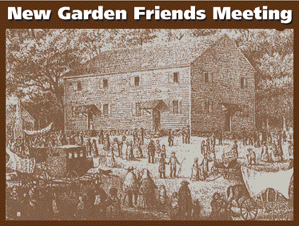
Eighth Generation
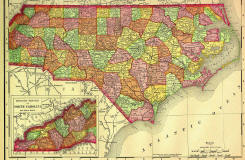 Martha BUNDY
was born on 19 Feb 1811
in Pasquotank, North Carolina. Martha first married William Lewis
MONTICUE, who we guess was born around the turn of the century and
immigrated from France when he was a boy of 17 or 18. William Lewis died
in Guilford Co., North Carolina in 1845, he was approximately 45 yrs old. Martha BUNDY
was born on 19 Feb 1811
in Pasquotank, North Carolina. Martha first married William Lewis
MONTICUE, who we guess was born around the turn of the century and
immigrated from France when he was a boy of 17 or 18. William Lewis died
in Guilford Co., North Carolina in 1845, he was approximately 45 yrs old.
On 2/18/1832 a
complaint from Symon's Creek Preparative Meeting against
Martha Bundy for
being the mother of an "illegitimate" child.
Mary Elliott and
Penninah Delon were appointed to visit her and on 3/17/1832 produced a
paper of disunity against her. Penninah was Martha's mother and Mary
must have been a family friend, Martha later sent one of her sons (William)
to Indiana to stay with an Elliott family after her husband William Lewis
Monticue died).
Martha, (we don't know if Martha met William
Lewis Monticue in Pasquotank or in Guilford) her mother Penninah, her sister, Mary
and her brother Joseph all migrated to Guilford County, NC, probably around
1837-1840. Other siblings could have also gone there and I 'm not sure
if they all went together, but I need to
check the records further. There are no records of Martha or her
mother Penninah in the Deep River Monthly Meeting in Guilford, but Martha
had been kicked out in 1831 for bearing an illegitimate son and perhaps the
rest of the family got kicked out too for other infractions or they simply
lost interest in the movement. There are references to her brother
Joseph who was still a member when they were in in Guilford County, but he too was later
"kicked out". No wonder the Quakers diminished, they kicked
everyone out !
Martha, her mother, and her brother among
others eventually migrated to Henry County, Indiana, around 1852 after
Martha's husband William died. Here is a great article on the
Quaker Migration to Indiana.
Martha Bundy and William Lewis Monticue had
the following children:
|
i. |
Samuel
Pike -
Born on 1 Jan 1831 in Pasquotank Co., NC. Samuel died in Crawford
County, Kansas on 26 Feb 1923, he was 92.
13 Apr 1854 when Samuel was
23, he married Sarah Ann NORMAN, in Monroe County, Iowa. Sarah Ann
died in 1909 in Crawford County, Kansas. Note: Samuel
was an illegitimate child born to Martha before she met William Lewis
Monticue. There was a Samuel Pike in the same "Meeting" as our
Martha and we suspect this is the father of her son Samuel. |
|
ii. |
William
Monticue -
Born in 1838 in Guilford County, NC. William died in Crawford County,
Kansas? |
|
iii. |
Benjamin
Franklin (Frank) Monticue (1840-1916) |
|
iv. |
David
Monticue - (1841-1909) |
|
v. |
Jesse Monticue - (see his life story) Born on 8 Jul 1843 in
Guilford County, NC. |
|
vi. |
Solomon
Monticue |
 On 28 Jul 1852 when Martha was 41, she
second married Andrew WILSON, in Henry County, Indiana. Born in 1804. On 28 Jul 1852 when Martha was 41, she
second married Andrew WILSON, in Henry County, Indiana. Born in 1804.
|

